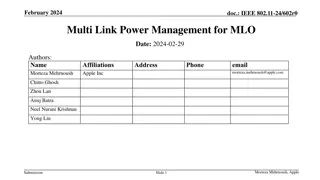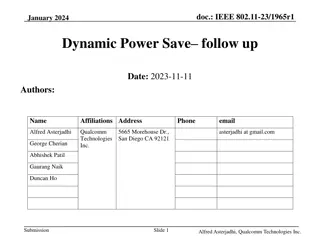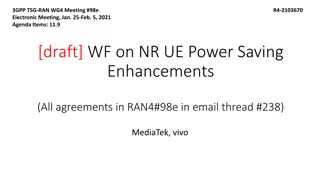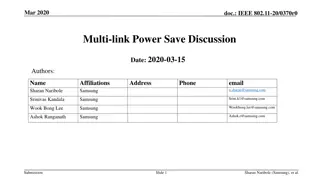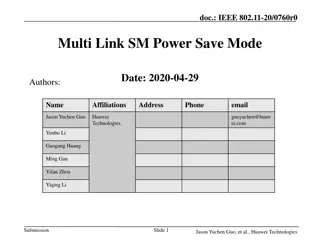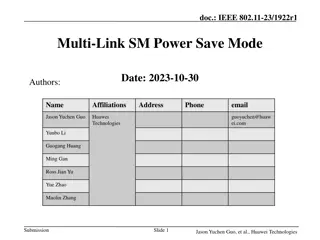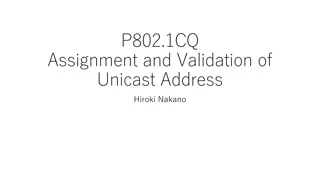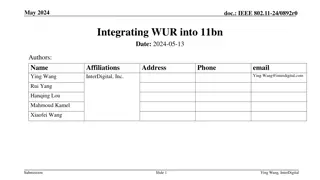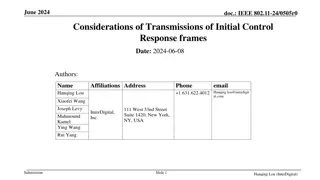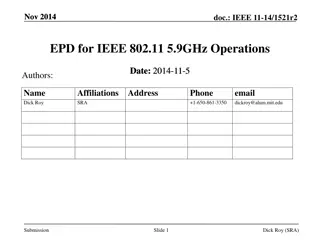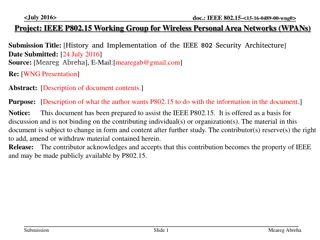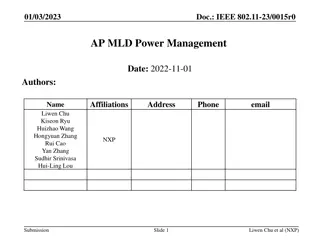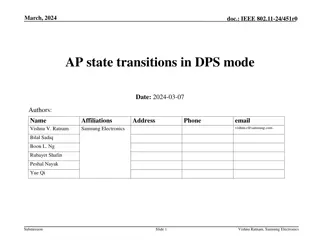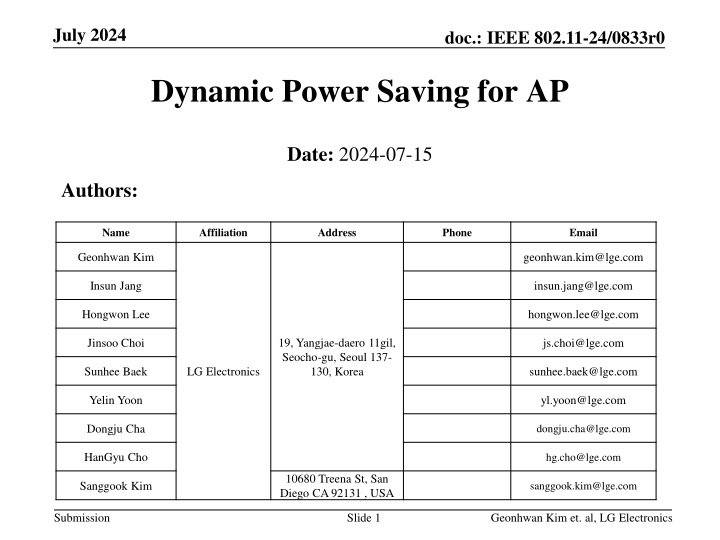
Dynamic Power Saving for AP in IEEE 802.11-24
This document discusses Dynamic Power Saving (DPS) mode for Access Points (APs) in IEEE 802.11-24, addressing issues with legacy STAs, introducing methods for APs' DPS operation, and detailing frame sequence examples.
Download Presentation

Please find below an Image/Link to download the presentation.
The content on the website is provided AS IS for your information and personal use only. It may not be sold, licensed, or shared on other websites without obtaining consent from the author. If you encounter any issues during the download, it is possible that the publisher has removed the file from their server.
You are allowed to download the files provided on this website for personal or commercial use, subject to the condition that they are used lawfully. All files are the property of their respective owners.
The content on the website is provided AS IS for your information and personal use only. It may not be sold, licensed, or shared on other websites without obtaining consent from the author.
E N D
Presentation Transcript
July 2024 doc.: IEEE 802.11-24/0833r0 Dynamic Power Saving for AP Date: 2024-07-15 Authors: Name Affiliation Address Phone Email Geonhwan Kim geonhwan.kim@lge.com Insun Jang insun.jang@lge.com Hongwon Lee hongwon.lee@lge.com 19, Yangjae-daero 11gil, Seocho-gu, Seoul 137- 130, Korea Jinsoo Choi js.choi@lge.com Sunhee Baek sunhee.baek@lge.com LG Electronics Yelin Yoon yl.yoon@lge.com Dongju Cha dongju.cha@lge.com HanGyu Cho hg.cho@lge.com 10680 Treena St, San Diego CA 92131 , USA Sanggook Kim sanggook.kim@lge.com Submission Slide 1 Geonhwan Kim et. al, LG Electronics
July 2024 doc.: IEEE 802.11-24/0833r0 Introduction There may be some restrictions for an AP (e.g., mobile AP) to operate as a Dynamic Power Save (DPS) mode. Basically, legacy STA does not understand DPS operation. Therefore, it may be impossible to transmit a control frame required for state transition in the currently discussed DPS operation [1 6]. In order for an AP associated with a legacy STA to operate in DPS mode; Notifies the legacy STAs of the AP s capabilities in the listening state (i.e., low capa.), or Assuming MLD, there may be a dedicated AP for legacy STAs. In this contribution, we propose two methods for AP s DPS operation. Option 1) A method considering only STAs that support AP s DPS operation Option 2)A method including STAs that do not understand/support the AP s DPS operation Additionally, the information and initial control frame (ICF) used for AP's state transition are introduced. Submission Slide 2 Geonhwan Kim et. al, LG Electronics
July 2024 doc.: IEEE 802.11-24/0833r0 AP s DPS operation: Option 1) Basically, UHR AP/STAs can indicate DPS capabilities and operating parameters. DPS capabilities may include whether DPS is supported, DPS operation status, etc. DPS capabilities and related operating parameters may be included in the beacon, probe req./resp., association req./resp. frames, etc. An AP that wants to enter DPS mode associates only with STAs that support the AP's DPS and broadcasts a frame containing an enable indication for DPS mode (e.g., DPS mode = 1). In this broadcast frame, the AP s DPS supporting STAs can obtain information such as BW, NSS, and MCS, etc. about the frame exchange state (i.e., high-capability state). Based on this information, the STA supporting the AP s DPS transmits an initial control frame (ICF) to the DPS enabled AP staying in the listening state. An AP with DPS mode enabled will stay in a listening state. The listening operation includes CCA and receiving the ICF of frame exchanges that are initiated by the non-AP STAs that support the AP s DPS. Alternatively, MLD can be used to exchange frames with legacy STAs. Some links are for servicing legacy STAs, and certain links can be used for DPS operations. Submission Slide 3
July 2024 doc.: IEEE 802.11-24/0833r0 Frame sequence in AP s DPS: Option 1) Example of UL frame sequence in AP s DPS operation Option 1) Example of DL frame sequence in AP s DPS operation Option 1) Submission Slide 4 Geonhwan Kim et. al, LG Electronics
July 2024 doc.: IEEE 802.11-24/0833r0 AP s DPS operation: Option 2) An AP that wishes to operate as DPS broadcasts a frame containing DPS enable indication. STAs that support the AP s DPS can obtain information about the AP s high-capability state. e.g., from the Capabilities element (or) fields that may be newly defined. On the other hand, other STAs can obtain information about the AP s low-capability state. e.g., from the corresponding (e.g., UHR, EHT, HE, .., etc.) Operation/Capabilities element The low-capability state, which is the default state for DPS operation Option 2) , may include the follow actions: CCA ICF reception of frame exchange initiated by STA supporting DPS Frame exchange with STAs that do not support DPS e.g., Receiving initiating frame from legacy STA & Transmitting frames that are initiated by the DPS enabled AP To do this, the use of RTS/CTS may be enforced (to HE/EHT STAs based on TXOP Duration RTS Threshold). STAs that do not support DPS perform frame exchange based on the operating parameters for low-capability state advertised by the DPS enabled AP. Submission Slide 5 Geonhwan Kim et. al, LG Electronics
July 2024 doc.: IEEE 802.11-24/0833r0 Frame sequence in AP s DPS: Option 2) Example of DL/UL sequence to the legacy STA in AP s DPS operation Option 2) Example of UL frame sequences in AP s DPS operation Option 2) Submission Slide 6 Geonhwan Kim et. al, LG Electronics
July 2024 doc.: IEEE 802.11-24/0833r0 Contents for AP s DPS operation The contents that can be included in a frame to operate in DPS mode are as follows: Contents for AP s low-capa. state (included in Operation/Capabilities elements for legacy) Max bandwidth (e.g., it may be limited to 20 MHz) MCS (e.g., low MCS) Max Rx NSS (e.g., NSS = 1) Contents for AP s high-capa. state (included in the newly defined Capabilities element) Max bandwidth (i.e., it may have a larger BW) MCS (e.g., MCS = 9) Max Tx/Rx NSS Padding delay for ICF required by AP Transition delay needed by AP Timer: timeout period for transition from high-capability state to low-capability state If the STA operating as DPS mode does not receive a response frame during timeout period, it switches back to listening/low-capability state. Submission Slide 7 Geonhwan Kim et. al, LG Electronics
July 2024 doc.: IEEE 802.11-24/0833r0 ICF/ICR frames for AP s DPS operation An AP with DPS mode enabled will stay in a listening (or) low-capability state. ICF is responsible for allowing the AP to transition from the listening state to the frame exchange state (Option 1) and to initiate frame exchange in the low-capability state (initiating frame in Option 2). The following frames can be used as ICF/ICR for STA s DPS: RTS / CTS Pros: Can be transmitted by non-AP STA, and is useful as an initiating frame for the low-capability state of Option 2). Cons: No padding/intermediate FCS provided for transition from the listening state to the higher capability state. BAR / BA Pros: Both AP and STA can transmit a BAR frame, and padding/intermediate FCS can be added/designed for ICF. Cons: There are some gaps between the role/purpose of an existing BAR and an ICF for DPS. Usually, BAR is transmitted to solicit BA and frame exchange is completed from this, but in DPS, BAR is transmitted to initiate frame exchange. MU-RTS Trigger / CTS Pros: It is advantageous in terms of protection and padding/intermediate FCS (if designed) is available. Cons: Non-AP STA cannot send a MU-RTS Trigger frame. BSRP / BSR Pros: It can include a padding/intermediate FCS to help transition from low-capa. state to high-capa. state. Cons: Non-AP STA cannot send a BSRP Trigger frame. Submission Slide 8 Geonhwan Kim et. al, LG Electronics
July 2024 doc.: IEEE 802.11-24/0833r0 Summary In this contribution, we propose a dynamic power saving operation methods for AP in terms of whether legacy STA is supported. Option 1) has the advantage that power saving efficiency of the AP may be higher because the AP only listens, but MLD should be considered to handle legacy STAs. Option 2) has the advantage of being able to transmit/receive with low capability with legacy STA, but the power saving efficiency of the AP may be reduced. In order for the AP to operate as a DPS, information related to the DPS operation of the AP that can be announced to STAs needs to be defined/discussed. In addition, it is necessary to determine the ICF for the purpose of switching the AP operating as DPS from the listen state to frame exchange state or initiating frame exchanges with the AP. For state transition, padding/intermediate FCS is the most important factor, And for the AP to operate as a DPS, it is important whether the STA can transmit ICF. Submission Slide 9 Geonhwan Kim et. al, LG Electronics
July 2024 doc.: IEEE 802.11-24/0833r0 References [1] 23/0010, Considerations for enabling AP power save [2] 23/1875, Power save proposal for non-AP/mobile AP [3] 23/1965, Dynamic Power Save follow up [4] 23/1936, AP MLD power save follow up [5] 23/2003, Client power save [6] 24/451, AP state transition in DPS mode Submission Slide 10 Geonhwan Kim et. al, LG Electronics
July 2024 doc.: IEEE 802.11-24/0833r0 Straw Poll 1 Do you agree to add the following text to the TGbn SFD? TGbn defines a power save mode for an UHR AP that is not a UHR mobile AP wherein the AP may transition from a lower capability mode to a higher capability mode upon reception of an initial control frame. Lower capability mode (e.g., 20 MHz BW, one SS, limited data rates, PPDU format) Higher capability mode (e.g., operating BW, NSS and MCSs, with at least one higher capability than that in the lower power capability mode) Initial Control frame is TBD Submission Slide 11 Geonhwan Kim et. al, LG Electronics


